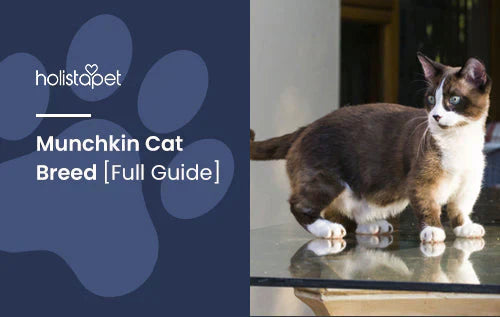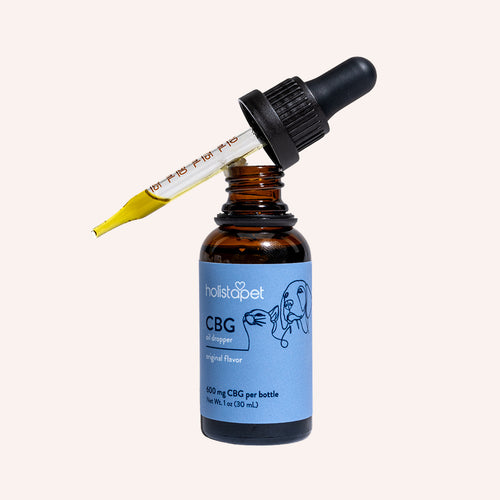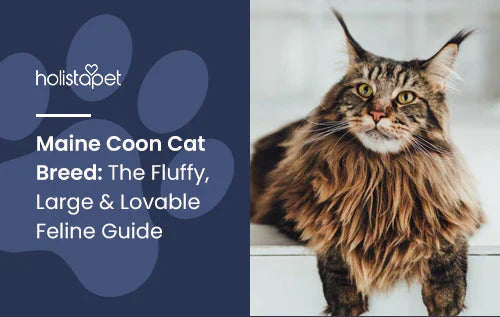If you're looking for a rambunctious and curious cat with a unique and adorable appearance, the Munchkin cat is the breed for you! Intelligent and playful, this short-legged feline is independent and endlessly entertaining. Cat fans can't get enough of their bushy tails, big eyes, and stubby legs.
Despite its adorable appearance, the Munchkin is a cat with a controversial past. But some official registries still refuse to accept the Munchkin as an official breed because so much is not known about their unique appearance. Read on to learn about the Munchkin cat breed origin, characteristics, and more.
Munchkin Cat Personality
Because of their physical characteristics and personality, the Munchkin cat full grown is often compared to a ferret. They're known to be extremely playful — and fast. Their fun-loving nature follows them well into adulthood. Munchkin cats are known to race around the house while utilizing their short legs to get excellent traction when they encounter a corner.
The Munchkin cat is also quite inquisitive and can be a bit noisy when you find them digging around in drawers and cabinets. Munchkins are known to take the things they find for themself, hiding them away where they hope you can't find them. These short-legged felines are also highly intelligent. They are known to exercise by playing fetch and will even obey voice commands. Provide them with interactive toys to keep them entertained and out of trouble.
When they are finally tuckered out, Munchkins enjoy a good cuddle. More often than not you'll find them curled up on the couch next to you or on your lap. This breed is extremely friendly, loyal, and enjoys spending time with its companions.

Breed Origin & History
Like the Dachsund, Munchkin cats owe their short legs to a controversial gene mutation. A veterinarian in the UK back in the 1940s was the first to document several generations of short-legged cats. By World War II, this unique line of stubby cats completely disappeared. In the United States during the 1980s, a woman named Sandra Hochenedel discovered a cat with short legs in Louisiana. She named her Blackberry.
The litter had both short-legged and regular-legged kittens. She gave one of the short-legged kittens to a friend, Kay LaFrance. The two cats were later bred together, becoming the first descendants of the Munchkin breed. Today, Munchkins are only bred with domestic cats with longer legs since their short legs are autosomal dominant. This means that it is not a sex-linked trait, and only one parent needs to have the gene. If both parents are Munchkin cats, the result, unfortunately, is an embryo dying in the womb.
The offspring of a Munchkin and domestic cat can have an equal chance of being another Munchkin, and only Munchkins carry their unique genes. While the Munchkin's breed standards state that they can only be recognized if they are bred with a domestic longhair or shorthair with no recognized breed, the Munchkins cat can be crossed with well-known pedigree cats to create short-legged varieties of those breeds.
Munchkin Cat Breeding
Even though Munchkins do not face the same debilitating back problems as short-legged dogs, there's still a lot of debate over the ethics surrounding Munchkin Cat breeding. Supporters of this unique breed state that the Munchkin lives a long, healthy life without any added complications due to their leg length. Some organizations beg to differ, saying that there hasn't been enough adequate research to support the absence of joint disabilities in this relatively young breed.
But the adamant support led to the Munchkin being accepted into The International Cat Association's New Breed development program in 1994. It was later fully recognized as a breed in 2003. However, due to the controversy, the Cat Fancier Association still doesn't recognize Munchkins as an official cat breed.

Physical Attributes Of Munchkin Cat Breed
The Munchkin cat is not recognized by the Cat Fancier Association, but The International Cat Association has created some breed standards of their own for this unique feline. While they can be bred with any domestic long hair or domestic shorthair cat regardless of appearance, there are a few specific traits that the Munchkin should possess.
Munchkin Cat Size
The Munchkin is considered a small to medium-sized cat with a moderate body type. Male Munchkin cats weigh between six to nine pounds, while the slightly smaller females weigh between four and eight pounds. They have a thick torso and a well-rounded chest with a tail that is typically the same length as their body. While they have some defined muscles, the Munchkin should not feel bulky.
Head
The Munchkin cat has a head that's in proportion to their body, with rounded features and defined cheekbones. This medium-sized breed's high set ears have a broad base and then become rounded at the tip. Their ears and large eyes give them an alert expression.
Eye Color
Munchkins have every eye color, and they don't have to have any correlation to their coat color and pattern. Their big, almond-shaped eyes can be blue, green, hazel, brown, yellow, or orange.
Legs & Paws
Munchkin cats have short, stubby legs. They should be set evenly apart, with the hind legs sometimes appearing more concise than the front. The Munchkin has round, compact paws that point directly forward. A funny thing this breed is known for is standing up on their hind legs, sort of like a rabbit. Because of their shorter hind legs, it's easier for this breed to balance in this funny pose. It's hilarious to see their stubby front legs dangle in front of them as they intensely eye something across the room or out the window!
Coat
The Munchkin cat can have either short or long fur. The shorthairs have an all-weather medium-length coat that's plush while longhairs have a semi-long and silky all-weather coat. Their coat should never be curly. All Munchkin cat colors and coat patterns are acceptable for this breed.

Munchkin Cat Breed Care
While the Munchkin is undoubtedly fast, their jumping is not as impressive. These short-legged cats unsurprisingly don't get too high off the ground. Like most cat breeds, they will still try to get onto the counters and furniture. To avoid any possible injuries, you may want to provide your Munchkin with ramps or steps so they can reach the couch and bed a bit easier.
If you have a short-haired Munchkin, you can get away with a weekly brushing. A longhaired Munchkin should be brushed or combed twice a week to prevent matting and tangles. Keeping up with this routine for both varieties will also lessen their shedding and reduce hairballs. Regular nail trimming and ear cleaning are also great ways to keep your Munchkin cat healthy and happy.
Use a veterinarian-approved cleanser for their ears, starting the process when they're kittens to get them used to the routine. Purchase a vet-recommended toothpaste to promote health and fresher breath. Provide your Munchkin with puzzles, toys, and brain games to keep them active and spry. This cat appreciates a good challenge, especially if it means they'll get rewarded with CBD Cat treats!
Munchkin Health Issues
Like most cat breeds, the Munchkin has an average lifespan of 10 to 15 years, as long as they're taken care of properly. Despite the controversy surrounding their genetic mutation, studies of older Munchkin cats have not been able to prove that there are any health concerns or conditions relating to their short legs.
While more research is yet to be done, there's currently no link between the Munchkin's stubby legs and any known health issues. Genetic mutation aside, there are a few common disorders and health concerns that are owners of this cat breed should be aware of. The first is a hormonal imbalance that can lead to accelerated metabolism, causing unintentional Munchkin cat weight loss and a rapid or irregular heartbeat. Owners of this cat breed should also look for symptoms of swelling of the pancreas that results in upper abdominal discomfort, queasiness, and spitting up.
Nutrition
Even though the Munchkin appears smaller than the average cat thanks to its short legs, their body is truly quite similar to that of other medium-sized cat breeds. You should feed your Munchkin cat the same amount of food as you would for a cat without short legs, with a focus on providing the right amount of protein and taurine.

As with every cat, make sure you are not overfeeding your Munchkin. They may be hard to resist with those stubby legs and big, bright eyes, but it's essential to stick to their recommended daily food portion. If you have a particularly greedy kitty, try implementing an automatic feeder that periodically feeds them throughout the day. This prevents them from scarfing down food right away and then demanding more later. When choosing snacks for your feline, we recommend getting treats with beneficial additives and high nutritional value. CBD Calming Chews for Cats can be a great option to promote relaxation while providing a tasty and nutritious treat.
Children & Other Pets
Munchkin cats are generally friendly and social, meaning they are usually perfect companions for other pets. They enjoy the company of other cats and well-behaved dogs. While they are not known to be aggressive, Munchkins are not as careful and gentle as other cat breeds, so they should always be supervised with younger children. They can get a bit unruly during playtime!
More About This Breed
You may have guessed it, but the Munchkin cat got its name from the characters on the Wizard of Oz. Kay LaFrance, mentioned previously in this article, used the name in her first Louisiana litter in the 1980s. The name most definitely stuck!
When other purebreds are mated with the Munchkin, there are even more fun names to discover:
- A cross between a Munchkin and a Sphynx or Devon Rex is called a Minskin.
- A Munchkin mixed with a Persian is known as a Napoleon or Minuets.
- When a Munchkin combines with a Selkirk Rex they take on the name Lambkin, due to their curly fluff.
- The same woman who created the Lambkin also gave us the adorable Kinkalow, a Munchkin mixed with an American Curl.
- The spotted Genetta descends from Munchkins, Bengals, and Savannahs, named after a small, slinky African cat.
Sometimes it can go even further. The Dwelf is a blend of the American Curl, Sphynx, and Munchkin. Their name is another exciting combination: dwarfs and elves. None of these purebred mixes are accepted as legitimate Munchkins by TICA — but they're adorable. The Munchkin is almost irresistible to cat lovers looking for an adorable companion.
Their short legs are unique, giving them a ferret-like appearance that matches their endless energy and curiosity. They're an independent breed of cat that is fine playing alone or cuddling with their favorite humans. While recent studies have pointed towards the Munchkin's genetic mutation being safe for the cat's well-being and health, it's a relatively new breed, and it should be noted that there's still a lot to learn about this intriguing cat.


 CBD Oil for Cats - Fast Acting
CBD Oil for Cats - Fast Acting
 CBD Cat Treats - Easy Dose
CBD Cat Treats - Easy Dose
 CBD Calming Chews for Cats - Highly Rated
CBD Calming Chews for Cats - Highly Rated
 CBG Oil for Dogs and Cats - Loved by Thousands
CBG Oil for Dogs and Cats - Loved by Thousands



![Aegean Cat [Full Breed Guide for This Rare Greek Beauty]](http://www.holistapet.com/cdn/shop/articles/Aegean_Cat_blog_981a4eba-811a-4589-8e03-632596efa5d7.png?v=1748469224&width=500)

Leave a comment
All comments are moderated before being published.
This site is protected by hCaptcha and the hCaptcha Privacy Policy and Terms of Service apply.